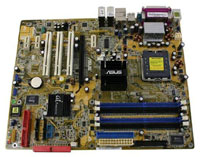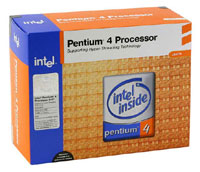Buyer's Guide - Mid-Range, January 2005
by Jarred Walton on January 21, 2005 11:09 AM EST- Posted in
- Guides
Intel Motherboard and CPU Recommendations
The Intel side of things is a little less difficult to assess. There haven't been any major developments lately that are due to upset the balance, so things remain largely unchanged. The impending launch of the 600 series processors will hopefully breathe some new life into the platform. With the lowest clocked models scheduled to run at 3.0 and 3.2 GHz and targeting a reasonable $200-$300 price according to recent Intel roadmaps, the Prescott 2M is definitely something to think about if you're not in any particular hurry. The additional L2 cache should boost performance to beyond current Pentium 4 Extreme Edition levels - the L2 cache is faster than L3 cache, remember - and given the much lower pricing of these mainstream oriented processors, it seems unwise to make a large investment in a high-end Pentium 4 right now. In the Mid-Range, however, price/performance is not likely to be dramatically different from current options, with an extra 10% to 15% performance coming from the cache upgrade. Waiting a few months for a 10% performance increase is just delaying the inevitable, so here is our Intel suggestion.
 |
 |
| Click images to enlarge. | |
Intel Platform Recommendation
Motherboard: ASUS P5GD1 (915P)Price: $116 Shipped
Processor:Pentium 4 540 (3.2 GHz) for 775 (Retail)
Price: $215 Shipped
While we haven't given the P5GD1 [RTPE: ASUS 915P P5GD1] a formal review, it shares many similarities with the Gold Editor's Choice P5GD2 from our 915P motherboard roundup. We chose the "lesser" board for a couple of reasons. First is price, with the P5GD2 generally costing $30 more than its little brother. The bigger factor also plays into price: the P5GD1 uses DDR RAM instead of DDR2. DDR2 continues to cost quite a bit more than regular DDR memory, and it has yet to show a tremendous performance advantage. Unlike the AMD options, there really doesn't seem to be any point in avoiding PCI Express on the Intel platforms, as you would have to opt for an older chipset and fewer features in order to go that route. This can be good or bad, depending on the graphics card that you plan on using, but we'll get to that topic shortly.
As far as features go, the ASUS board has pretty much everything that you could want. The integrated gigabit Ethernet (GbE) is on the PCI Express bus, so performance is not limited by the slower PCI bus. That really doesn't seem to matter too much, however, as nearly all GbE setups that we've tested can handle 30 to 40 MB/s transfer rates, which is usually as fast as any non-RAIDed hard drive setup. Only serious networking types are likely to be concerned with maximum GbE performance. One minor shortcoming is that unlike the P5GD2, ASUS decided to use a cheaper non-HD audio solution. We would have preferred the Azalia HD solution, but the Realtek ALC861 8 channel audio is plenty good. If you plan on adding your own sound card, this becomes a moot point, but we certainly don't feel that better sound hardware is necessary.
For the processor, we try to keep things relatively close to the price and performance of the AMD system by going with the 3.2GHz Pentium 540 [RTPE: BX80547PG3200E]. We actually end up being slightly cheaper than the AMD platform here, due to the lower cost of the motherboard, but overall, the AMD system will often outperform the Intel system, so that seems fair. There are still areas where Intel leads in performance, most likely due to better optimizations for their architecture; so if gaming isn't your primary concern, it becomes more of a toss up. A slight upgrade in performance via the P4 550 is also something to consider, but for a $60 price increase, you only get an extra 200MHz, so it's not a great bargain.










46 Comments
View All Comments
JarredWalton - Wednesday, January 26, 2005 - link
^^^ Er, Foxconn is at MonarchComputer.com, not GameVE.JarredWalton - Wednesday, January 26, 2005 - link
44 - This was written by January 18th and published Jan 21st. Things change rapidly, which is why the Buyer's Guides are really just a snapshot in time. There are several NF4 boards now available at Newegg, including the Chaintech and an MSI Neo4 Platinum. Odd that the Chaintech lists "NVIDIA 7.1-channel audio" - is SoundStorm back with NF4? I don't think I had heard about that. The Gigabyte board is also available from quite a few other resellers besides Newegg, of course. There's even a $109 Foxconn NF4 board at GameVE. Interesting! Not that I've had any good Foxconn experiences, but $109 is attractive.jleandro - Wednesday, January 26, 2005 - link
Don't want to be a pain, you guys review whatever boards you think are worthy, but I just checked Newegg and here's what they had IN STOCK:CHAINTECH NVIDIA nForce4 Ultra Chipset Motherboard For AMD Socket 939 CPU, Model "VNF4/Ultra" -RETAIL US$ 135
MSI "K8N Neo4 Platinum" NVIDIA nForce4 Ultra Chipset Motherboard For AMD Socket 939 CPU -RETAIL US$ 159
GIGABYTE "GA-K8NXP-SLI" NVIDIA nForce4 SLI Chipset Motherboard For AMD Socket 939 CPU -RETAIL US$ 249
ASUS "A8N-SLI Deluxe" nForce4 SLI Chipset Motherboard For AMD Socket 939 CPU -RETAIL US$ 265
Interesting that the Gigabyte K8NF-9 was actually not in stock.
hawksballer - Tuesday, January 25, 2005 - link
JarredWalton - Monday, January 24, 2005 - link
41 - Guide editors changed a few months back. The "alternative" configurations have always been more expensive, and they include *all* the alternatives, usually. If you were to take this Guide's alternative (NF4) and stick with the recommend parts everywhere else, price would drop considerably. I haven't made a point of highlighting this, but I did change the pricing targets a bit on the Guides.For the budget, I typically try for $500, but I usually end up closer to $600. Compromises to drop the price are possible but undesirable, i.e. go with 1x256 MB of RAM. The Budget altenative I generally target slightly below the Mid-Range, so $900 to $1000 is usually where it lands.
The Mid-Range has been bumped to $1250 by default, which generally allows for a very good all-around system with few (if any) compromises. The alternative Mid-Range I try to keep under $2000, although closer to $1750 is desirable.
I haven't done any High-End or OC Guides, but High-End will be in the $2000+ range (maxing out at $4000 or so with *all* the trimmings), and the OC Guide is really just about any of the above price goals. I'm working on one of those.
Hopefully that answers your questions. If you want to trim costs a bit on the Mid-Range, going to a slower CPU and GPU usually cuts close to $200, but then it's no longer an all-around system.
-------------
#40: The Chaintech may very well be available in Hungary, but it is not at all available in the US right now. Newegg is the one of the few sites that even list it, and any boards have disappeared *FAST*. If you picked on up without difficulty where you live, more power to you! Lucky #@$^&*%! ;)
wilburpan - Monday, January 24, 2005 - link
Is it just me, or have the Mid-Range and Entry Level Buyer's Guides suffered from price inflation? It seems to me that way back when, the price points for these two were a solid $1000 and $500, respectively. Now the Entry Level Guide has a budget of up to $1000, while the Mid-Range Guide is pushing $2000.I can understand that picking price points is an arbitrary process, but I would think that for comparing what your computer dollar buys you over tme, it would be nice to remain consistent.
jleandro - Monday, January 24, 2005 - link
Can't understand why the Chanitech NF4 Ultra Zenith is not considered to be available.I live in Hungary (not the prime tech spot) and this board has been available for some time, most retailers have it.
In fact I just bought one today for ~110 USD and will pick it up tomorrow.
For instance, check http://www.e-connect.hu under "alaplapok" (motherboard in Hungarian).
JarredWalton - Monday, January 24, 2005 - link
38 - Thanks. It's corrected now. The marketing for the drive states "with SATA-II features" and somewhere along the line that got put in as SATA-II. :| Basically, the drive has hot-swap capability and NCQ, which are both SATA-II. It does not support 300MB/s, but then burst transfer rates really matter much. With sustained transfer rates of even the fastest drives maxing out around 70 MB/s, it will be quite some time before SATA-II transfer rates really show real-world benefit.37 - 0dB computing? I'm not sure I'm the one to address that, but it's certainly something to think about. I'll pass that along and see if we can acquire the parts for such a test. They're relatively expensive in comparison to fan-based solutions, unfortunately.
AnnihilatorX - Monday, January 24, 2005 - link
JarredWalton:A misleading information I just found and thought would like to point out...
The Maxtor Diamond Max 10 300GB with NCQ 16MB cache (6B300S0) is SATA-I/150 in terms of transfer speed, but not SATA-II/300 as stated in page 6.
http://www.anandtech.com/guides/showdoc.aspx?i=232...
"Maxtor 300GB SATA-II with NCQ and 16MB cache"
ceefka - Monday, January 24, 2005 - link
Again a great guide. I was already interested in the Maxtor 300 GB SATA II. I guess in that case you'll have to go with the Gigabyte GA-K8NF-9 or any of the other nForce 4 boards.Would it be a challenge for AT to build a 0dB PC with high end components with Intel and AMD and compare notes. This machine should at least be a mid-range performer or just as high as you can go on 0dB.
I wonder because I'd like to build something really quiet. I have already looked into components like Yesico FL420 and fanless CPU coolers, but I am not sure if all of that will work with also two Maxtor 300GB SATA-II's in http://www.blacknoise.de/shop/de_DE/produkte/id_is...